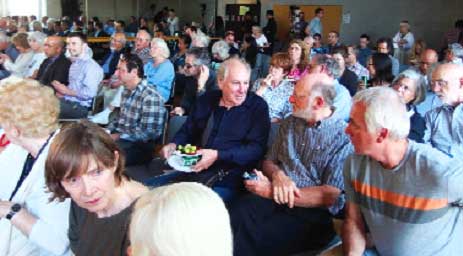On May 28 at the Harbourfront Community Centre, the Toronto Society of Architects convened its third urban affairs forum of 2015. The topic was “Toronto Island Airport: Urban Design considerations.” The event was meant to be a dispassionate examination of the proposal by urban design specialists for urban design specialists. Things did not quite go off as expected .
.
A harbinger of where things were going came early when one lady looked at the pleasant but hardly lavish refreshment buffet and said very audibly, “I bet Porter paid for all this.” (Porter hadn’t).
The room held two solitudes. One: Porter CEO and panelist Robert Deluce—who aggressively defended the expansion plans, and two: apparently, the remainder of the room and panel, who opposed them vigorously. At least, if there were other pro-expansion voices in the room, they were silent. Some of the opposed were prepared to be vocal (forced laughs and boos) until gavelled by the moderator. Deluce—who, frankly, is far from his own best advocate in public debate—responded with aggressive dismissal of the critics’ qualifications.
The dance studio was filled to capacity by about 100 attendees, TSA chair Jason Dobbin told The Bulletin afterward that that was about a normal turnout but added, “I didn’t recognize about a fifth of the people here tonight.”
Normally, the organizers charge $12 admission fee: this time it was open to the public for free. The 20 whom Dobbin did not recognize were almost all members of the assorted community and activist groups that make up No Jets Toronto, plus a media representative or two. Dobbin said that he had realized the discussion would be “contentious” but organizers seem not to have anticipated quite how contentious.
Urban designer Ken Greenberg, a leading voice against expansion, led off the evening with a recapitulation of the arguments against the expansion; from a design perspective two points stood out.
The first was scale; Greenberg suggested that the proposed expansion along with its water exclusion and safety zones for approach and takeoff would overwhelm any other element of the waterfront and effectively block the Western Channel and proposed redevelopments at Ontario Place.
The second was traffic flow: Greenberg and other panellists pointed out that the necessarily increased vehicular traffic to the airport would be channelled through one already heavily residential neighbourhood. Greenberg also underlined a major process problem: that Transport Canada will not establish exclusion zones and height limits—and therefore define actual impact on the waterfront—until after any decision by city council, thereby leaving council in the position of buying a pig in a poke.
Greenberg told the audience, “These are not incremental changes or ‘adjustments,’ this is a profound change in kind and scale. We would be going from an airport on the waterfront to a waterfront in the airport.” He also noted that expansion of Downtown waterfront airports goes against global trends, citing Chicago as an example.
He also made the point that the environmental assessment currently on the table had been commissioned by the applicants for expansion and that therefore its impartiality was open to challenge.
Greenberg was followed by Deluce, who presented Porter’s business case for expansion and the noiselessness and reduced pollution of the proposed jets. He noted that the airport itself is much smaller than comparable airports in other cities (Ottawa, Chicago), and that the number of flights per day would be constrained by a short single runway. He was silent on urban design issues.
During the general discussion resident Jim Panou, research chair of No Jets Toronto coalition raised the issue of the approach cone over the Port Lands at a very low altitude, to be told by Deluce,
“Obviously your background in this subject is probably inadequate for making a determination as whether something is approved or not. I would suggest that’s not your prerogative.” (Scattered boos were heard.)
Panellist Bruno Weber (KPMB) reiterated that scale was the major issue. Then calling attention to Deluce’s comparative numbers on other airports, said “when you see what is being squeezed into this very small site and you see the impacts, if you look at what’s happening out on Bathurst St. right beside us here, and you imagine a more than doubling of the number of passengers, for the life of me I don’t know how you satisfy the intersection of Lakeshore, Bathurst and Fleet St. There is no magic solution that will bring the subway over here.
“This is now a ‘briefcase’ airport. When it becomes a ‘suitcase’ airport [with large amounts of luggage], it becomes an entirely different thing.”
Bob Rasmussen, co-chair of York Quay Neighbourhood Asson. complained, “I was disappointed in much of the discussion tonight,”
I came expecting to hear design considerations, and what I got was basically a commercial for flying planes to other countries. That’s not what I came to hear.”
Rasmussen continued: “How from a design point of view, do you pump basically the same amount of traffic as Ottawa Airport down one residential street?”
Panelist Svetlana Lavrentieva could not see a traffic solution either but asked what kind of legacy does the city want for the waterfront? “I hope it’s sustainable, I hope It’s resilient, and I hope it’s pedestrian-friendly.”
Greenberg also could see no solution “but even if there were, the city would have to pay for it.” He noted that Waterfront Toronto, representing three levels of government, has come out against the proposal as damaging and incompatible.”
Deluce commented that there are plenty of innovative minds that could produce innovative solutions: “Over 113 years ago, there were a lot of people that doubted that man was meant to even fly and the Wright Brothers proved that wrong. Usually where there’s a will there’s a way.”
Two solitudes.
 TheBulletin.ca Journal of Downtown Toronto
TheBulletin.ca Journal of Downtown Toronto

